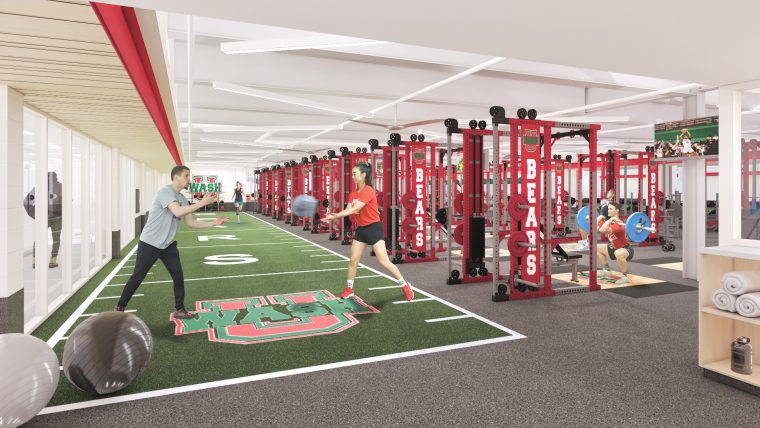Athletic Department News | Sports
New Sports Performance Center to be added to the Athletic Complex, student-athletes cautiously optimistic

A rendering of the new space shows expanded facilities. (Photo contributed by WashU Athletics)
In an effort to continue its branding of Division III sports combined with Division I facilities, Director of Athletics Anthony Azama announced the University’s plan for a new sports performance center. The 7,000-square-foot center will be located within the existing athletic complex by the sports medicine area, in a currently unused space dubbed the “shell space.” With this addition, which is aimed to be completed by fall 2022, the University is looking to build towards the future of WashU Athletics both for current student athletes and future recruiting efforts.
An Athletic Department press release stated that the center will contain 16 Samson rack stations, a 30-by-5 yard turf area for training exercises and a state-of-the-art air conditioning system. The new space will fit up to 80 athletes, an expansion from the prior weight room. The athletic department has not publicly announced how they plan to repurpose the former weight room space.
For student athletes currently competing for the Bears, the new project will have an immediate quality on their team lifts and strengthening. “Having a bigger space to do our workouts is huge,” said senior softball player Katie Gould. “We have to share the current small weight rooms that we have with other teams. It’s super crowded, and it’s hard to get the weights you want.”
Now, she said, having the new facility will allow them to push more weight and be more comfortable in the weight room, with less risk compared to the current space. “You don’t want to get injured by a weight coming at you,” Gould said. “Currently, there’s a lot of obstacles to training and getting in the work that we need.”
For larger teams like football, the new facilities will make team practices exponentially easier since it will allow space for all their players. “It just adds a lot of excitement for us,” said rising junior football player Collin Hoyhtya. “I definitely feel like we could use the upgrade, and I think everyone’s really excited to keep applying ourselves to the game in a new facility.”
This addition comes on the heels of the renovation of the varsity softball and intramural field, a multimillion dollar project that was completed days before the beginning of the Bears’ season. The new field includes synthetic turf, a new press box and ADA seating. The new sports performance center is the next step in Azama’s vision for updated facilities and elevating the brand of the WashU Bears.
Alongside the immediate impact for current varsity athletes, the addition of the facilities will have long-term impacts on the recruiting process, with coaches being able to show polished, new facilities to attract incoming freshmen. “You better believe that we’re going to use that this summer as a recruiting pitch,” said head baseball coach Pat Bloom. “Ultimately, things like that—they’re not just a nice showpiece. They also tend to attract the type of kids who really want to get the most out of their athletics experience. It sends a message to the kids that athletics really matters here.” With men’s basketball also promoting Division I facilities alongside their 26 NCAA tournament appearances, the social media platforms of individual teams have been piggybacking off of this announcement to increase their recruiting appeal.
Funding for the new center came from both external fundraising and internal money from within the department, and Azama has had to juggle the competing needs of the different teams. The decision to set aside funding for the new sports performance center, he said, was an easy one. “Typically, what the Athletic Director would do is look at what the guidelines [are] to determining the priority of projects,” Azama said about his rationale. “Sometimes it’s [asking] ‘Does the project impact multiple rosters? Will the project help in recruiting? Will the project help enhance the student athlete experience?’ And then you have an opportunity to address equity, and that will rise above all else.”
When reflecting on what the teams lost during the pandemic, Azama sees the creation of these two new facilities as promising ways to move forward after the athletic cancellations of the fall and spring seasons last year. “This is an exciting opportunity to be at Washington University,” Azama said, reflecting on having four athletes explore potential professional careers in the past two years. “This stuff we’re trying to do for these athletes is the least that we could do.”
Still, at least among some student-athletes, there remains uncertainty about some projected elements of the project, including the location of the new space and the timeline. Older players have been hearing promises of a new sports performance center since their recruitment visits and have yet to see it actualize, so some have told the underclassmen to not get their hopes up.
Sophomore football player Johnathon Smith described his outlook as “cautious optimism”; he trusts Azama’s commitment to the athletic program. Regardless of where he is, Smith will be putting in the work to be successful in the fall anyway. “If we get that new facility next fall, that’ll be awesome. If we don’t, it still looks awesome,” he said. “Regardless, we’re always gonna make it work. I mean, this is Division III, right? Regardless of what type of facilities you have, you have to have the mindset that you’re just gonna go in and grind because you love it.”
Managing sports editor Clara Richards contributed reporting.
